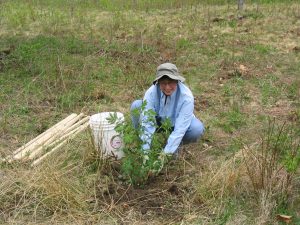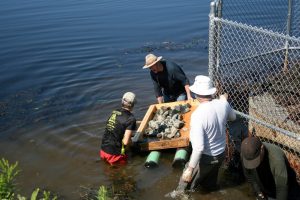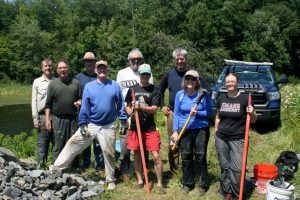Shrub Islands
The value of the FLCA’s pastures for wildlife depends upon the control of invasive plants and periodic mowing to maintain these areas as shrubland or early successional habitat. In 2005, we initiated an experiment aimed at enhancing the environment of the pastures by establishing small “islands” of native shrubs and small trees in Cooke’s Pasture to provide food, shelter and nesting areas for native birds, many of which are in decline in Massachusetts owing to the loss of appropriate habitat. Plants were selected mainly for the value of their fruit for shrubland birds, such as woodcock, ruffed grouse, black-billed cuckoo, brown thrasher, willow flycatcher, eastern kingbird, indigo bunting, eastern towhee, field sparrow, and chestnut-sided and blue-winged, warblers, many of which can be observed at the FLCA. A secondary objective of this program was esthetic as the plants we used produce attractive flowers in the spring as well as fruit later in the season. Shrub islands, each encompassing about 750 square feet, were introduced into Cooke’s Pasture in 2005, 2006 and 2007. A wide variety of plants–all New England natives–were tested for their ability to become established in this environment with little care except for occasional watering to supplement natural rainfall; they included red and black chokeberry, blueberry, winterberry, bayberry, spicebush, elderberry, serviceberry and several species of native dogwoods and viburnums. We have noted marked differences in the hardiness of the different species. Among those that have proved to be most robust are bayberry, winterberry, serviceberry, dogwoods and several species of viburnum. We have continued to maintain the shrub islands through annual pruning, removal of competitors, and limited replacement of plants that succumbed because of harsh weather or excessive browsing.

Maintenance of the Lake Fitzgerald Outflow Drain
Over the years, beavers have demonstrated enormous ingenuity in blocking the Fitzgerald Lake outflow drain, causing unacceptable rises in the lake level which sometimes left the canoe launch covered with over a foot of water. In the summer of 2005, Mike Callahan of Beaver Solutions installed a wire fence around the drain to limit beaver access, but by the following spring, the beavers had completely plastered the fence with mud and vegetation, once more causing the lake level to rise. This time, Callahan installed a “pond leveler pipe” on the bottom of the lake that connects with the drain underwater. Although the beavers never sicceeded in blocking this pipe, the wire fence deteriorated over the years and the lake level started to rise once again. The old fence was replaced by a much tougher chain link fence in 2013. But the new fence didn’t quite reach to the bottom of the lake; the beavers simply swam under it and once again blocked the drain. The ultimate solution came in 2015 when a half ton of trap rcock was placed around the bottom of the fence by a group of volunteers, blocking the beavers for good. Since that time, the lake has remained at its normal level.

